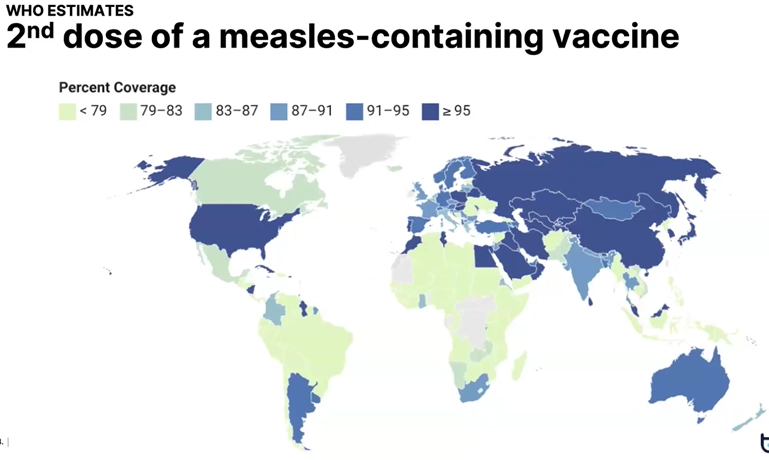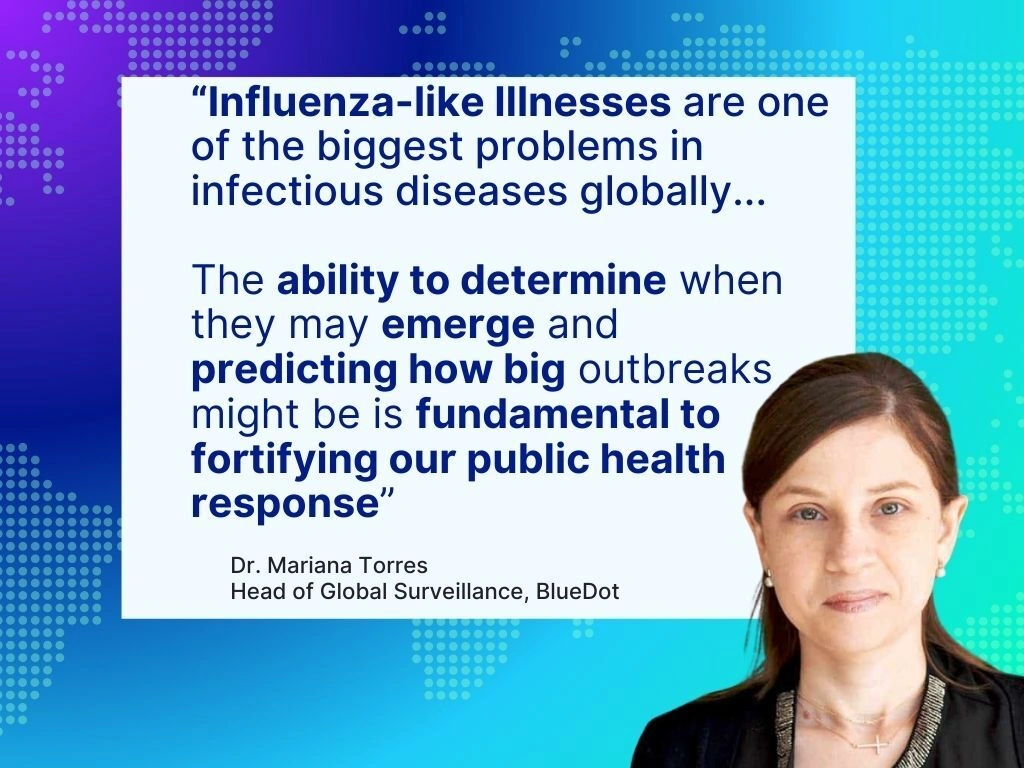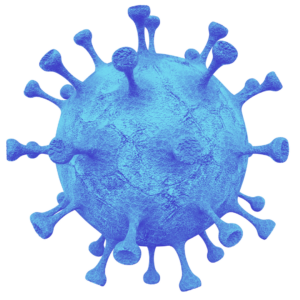In an ever-changing landscape of emerging infectious disease threats, AI has the power to spot them sooner — and sound the alarm earlier — than ever before
The worst of the COVID-19 pandemic may be behind us, but the sense of alarm about emerging infectious diseases remains front and centre. Infectious diseases are increasing in frequency, scale and impact — in fact, there have been more global health emergencies in the last 24 years than there were in the entire 20th century. The world’s population is also more mobile than ever before — total airline passenger volume reached over 8.5 billion travelers in 2023, to say nothing of human sea, rail and automobile travel, nor of animal migrations. Infectious diseases are often stowaways on these voyages and can spread rapidly before they are even noticed. In this interconnected world, we all need to be on the lookout for emerging and re-emerging diseases, even on the other side of the globe.
In our most recent webinar, BlueDot’s 2024 Watchlist: The top 5 infectious disease threats you can’t ignore, BlueDot Medical Science Liaison Dr. Hernán Acosta outlined the features of the top 5 existing and emerging infectious diseases that BlueDot’s surveillance team is watching out for now, including the ways they spread, the risks they pose, and how to navigate them.
While this list reflects the 5 most relevant infectious diseases in BlueDot’s estimation, this list can look quite different depending upon the organization, its location, its people and its priorities — and could even be longer. Nevertheless, these are the ones that BlueDot believes are likely to have a broadly significant impact.
The old and the unusual: emerging and re-emerging infectious diseases
The first infectious disease threat on BlueDot’s watchlist is an emerging one: avian influenza. Also called ‘bird flu,’ it’s a virus that spreads via direct or indirect contact with infected animals or environments. A particularly concerning subtype of the H5N1 strain (2.3.4.4.b) has popped up in North America and in locations previously untouched by bird flu, including Ecuador and Spain. It has also been found in unexpected species – including mammals such as bears, foxes and, more recently, cows. Geographical expansion and evolution of the pathogen’s properties pose concerning risks to humans. Federal agencies in the United States have stockpiled both treatments for the disease and the building blocks needed to manufacture vaccines, and have the ability to ramp up production quickly.

The second disease on BlueDot’s watchlist is a re-emergence of one of the world’s most transmissible diseases: measles. An airborne virus that can stay in the air for up to two hours, measles is an infectious disease that had a devasting impact prior to the approval and distribution of a vaccine in the 1960s. But vaccination against measles is on the wane worldwide. In high-income countries, increased vaccine hesitancy is partly to blame, while declines in low-income countries are due primarily to challenged healthcare systems whose resources have been stretched thin since the COVID-19 pandemic.
To effectively curb the spread of disease, at least 95% of the population needs to be vaccinated. As the map above shows, even some high-income countries such as Canada, with an immunization rate of 79%, have fallen well below that threshold. Since an effective measles vaccine exists, measles outbreaks — and the significant disruptions they will cause — can be minimized by mounting education and vaccination campaigns that address vaccine hesitancy and make the vaccine easy to get, including time off work to allow people to get vaccinated.
Dengue, the third infectious disease on BlueDot’s list, is a viral infection that spreads through mosquitoes. As discussed in a previous BlueDot webinar focused on mosquito-borne diseases, it is a growing threat as climate change expands mosquito territory and times that they are biting during the year. In the first two months of 2024, Brazil surpassed 1.5 million cases – 20,000 cases per day – and nearly 300 deaths. By contrast, Brazil reported a total of 1.7 million cases of dengue for all of 2023. In March, Peru declared a health emergency as it faced more than 31,000 cases, doubling last year’s rates over the same period. And while countries such as these have been battling dengue for years, the concern now extends to the preparedness of those that haven’t. Cases have been reported in Florida and southern Europe, and it’s showing no signs of slowing down. As the climate continues to change, the transmission of dengue, and other infectious diseases, will make its impact felt.
5 Top Takeaways:
Today’s Emerging Infectious Disease Threats
1. Bird flu evolves, spreading in ways not yet seen. Expansions in avian influenza’s geography and changes in its pathogenic properties pose new and potentially devastating risks to humans.
2. Measles makes a comeback. With decreased vaccination rates, outbreaks are occurring in both high- and low-income countries.
3. Dengue draws new boundaries. As climate change expands mosquito habitats, dengue can spread to new places that are not prepared to fight it.
4. Disease X lurks – an expected but unknown emergence. It’s a matter of when – not if – this mystery disease becomes a regional threat, if not another pandemic.
5. Disease warfare and accidentally released infectious diseases are now on the watchlist. Rising global unrest increases the risk of intentional, nefarious infectious disease spread. And lack of oversight in infectious disease research means unintentional release is possible.
Disease X and other unexpected infectious disease threats
The fourth infectious disease threat on the list is a pandemic pathogen that is not-yet characterized – Disease X. We don’t know what it is, but we’ve seen certain diseases, including mpox and polio, re-emerge in unexpected ways. As Dr. Acosta explains, “we should think of Disease X as something that has yet to appear but is likely already here.”
He stresses the importance of monitoring population movement and being aware of what’s happening on the global level. On the heels of the COVID-19 pandemic, governments and organizations need to confront the reality that we will have another pandemic – and we need to be prepared. But when is it coming? Do we have enough time to prepare? Are our healthcare systems ready to deal with it – whatever it is? Because all we have right now are questions, says Dr. Acosta, surveillance becomes all the more important in the search for answers.

The fifth and final threat to keep a lookout for is the intentional and unintentional release of infectious diseases. The possibility of infectious diseases being used maliciously in armed conflict is an ever-growing concern given both advancements in technology and rising diplomatic tensions around the world. Technological advancements also increase the possibility of the unintentional spread of infectious diseases amidst a lack of oversight in biosecurity measures. While the risks from natural causes are increasing due to climate change, instability, human movements and other factors, we can’t ignore the possibility of manmade infectious disease threats that pose risks to public health, whether intentional or not.
Mounting the best early defense against infectious disease threats
While infectious diseases can leave us feeling worried and helpless, we have the power to mitigate their effects. “The solution is three-fold: awareness, education, and communication,” says Dr. Acosta. “These are the main proactive strategies that can have an impact regardless of your level of oversight. Enhanced awareness will grant you an advantage, education will allow you to come up with solutions, and communication will cement the advancements of these solutions at a scale that is replicable.” These strategies will help to truly understand the risks and respond swiftly at the individual, community, and global levels.
To keep up, health systems and other organizations need effective infectious disease surveillance — which is precisely what BlueDot does. A vital part of infectious disease prevention, surveillance is an ongoing, highly complex process of data collection, analysis, and interpretation to monitor trends, detect outbreaks, and respond to them. According to Dr. Acosta, BlueDot’s surveillance has evolved over time to include more sources of data, broader geographic scope, timelier surveillance activities, and syndromic surveillance – among others.
The most impactful change, says Dr. Acosta, has been the integration of artificial intelligence (AI). “This has changed the volume of information we can handle, the type of information we can access, and how we ingest it,” he says. At BlueDot, the use of AI has allowed for automated tracking, meaning time is spent understanding outbreaks and tracking several threats concurrently.
Because emerging infectious disease threats are often poorly understood, especially in their earliest stages, it’s essential to adapt the approach to monitoring them. This means being able to filter out noise and misinformation to really understand what’s going on. “In the world of epidemics and preparedness, lack of awareness and overload of information can be disastrous for population health,” says Dr. Acosta. With the right tools and dedicated surveillance teams to catch threats early, we will have a fighting chance when the next outbreak – or pandemic – strikes.











